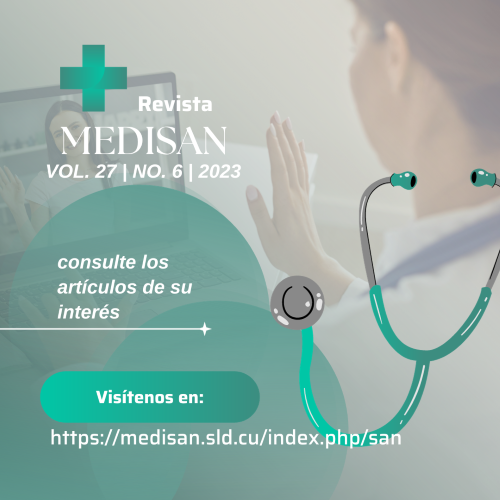Sociodemographic and epidemiological characteristics of patients with clinical onset of AIDS in Santiago de Cuba
Keywords:
sexually transmitted diseases, HIV, acquired immunodeficiency syndrome, AIDS-related opportunistic infections, epidemiology, clinical diagnosis.Abstract
Introduction: One of the millennium challenges worldwide is to fight the advance of the human immunodeficiency virus/aids.
Objective: To characterize the sick population with clinical onset of AIDS according to sociodemographic and epidemiologic variables.
Methods: An observational and descriptive study was carried out, from 2017 to 2021, of 87 people diagnosed with clinical onset of AIDS in Santiago de Cuba province. In the statistical analysis, measures of central tendency and dispersion were used, as well as the distribution of absolute and relative frequencies; also, confidence intervals of 95% were computed for the proportions of selected variables.
Results: The average age in the series was 42 years (79.3%), likewise, there was a prevalence of the male sex (91.9%), single as marital status (91.9%), working bond (72.4%), mixed race (52.8%) and black skin color (39.3%), and the urban origin (73.5%). The anal coitus was the main way of infection (84.0%), while the majority of the affected individuals of both sexes (65.2% in males and 66.7% in females) did not use condoms and homosexuality predominated among men (55.0%).
Conclusions: The clinical onset of AIDS prevailed in young and single men, with working bond, among whom risky sexual behaviors were very significant.
Downloads
References
2. AIDSinfo. Ginebra: ONUSIDA; ©2020-2022. Global factsheets 2022 [citado 20/04/2023]. Disponible en: https://aidsinfo.unaids.org/?did=5fbeb5cb94831556e11c4517&r=world&t=null&tb=q&bt=undefined&ts=0,0&qla=G&qls=All%20Countries
3. Cuba. Ministerio de Salud Pública; Dirección de Registros Médicos y Estadísticas de Salud. Anuario Estadístico de Salud 2021. La Habana: MINSAP; 2022 [citado 08/04/2023]. Disponible en: https://instituciones.sld.cu/fatesa/files/2022/11/Anuario-Estad%C3%ADstico-de-Salud-2021.-Ed-2022.pdf
4. Wilton J, Light L, Gardner S, Rachlis B, Conway T, Cooper C, et al. Late diagnosis, delayed presentation and late presentation among persons enrolled in a clinical HIV cohort in Ontario, Canada (1999-2013). VIH Medicine. 2019 [citado 08/04/2023];20(2):110-120. Disponible en: https://onlinelibrary.wiley.com/doi/epdf/10.1111/hiv.12686
5. Salamão Chone J, Barroso Abecasis A, Varandas L. Determinants of Late HIV Presentation at Ndlavela Health Center in Mozambique. Int J Environ Res Public Health. 2022 [citado 08/04/2023];19(8):4568. Disponible en: https://www.ncbi.nlm.nih.gov/pmc/articles/PMC9031287/pdf/ijerph-19-04568.pdf
6. Huergo JA. Formas posmodernas de lucha contra el hedor: el caso SIDA. Margen Revista de Trabajo Social. 1997 [citado 16/05/2023];10. Disponible en: https://www.margen.org/suscri/margen10/siete.html
7. Castellanos Bertot Y, Correa Iznaga L, Stay Calvo S. Caracterización clínico-epidemiológica de pacientes con VIH/sida en el municipio Manuel aranés, Guantánamo. Revista Información Científica. 2021 [citado 12/06/2023];100(6):e3577. Disponible en: https://www.redalyc.org/journal/5517/551769500006/html/
8. Cuba. Ministerio de Salud Pública. Plan Estratégico Nacional para la prevención y control de las ITS, el VIH y las hepatitis 2019-2023. La Habana: MINSAP; 2019.
9. Programa Conjunto de las Naciones Unidas sobre el VIH/sida. En peligro: ONUSIDA Actualización mundial sobre el Sida 2022. Ginebra: ONUSIDA; 2022 [citado 26/05/2023]. Disponible en: https://www.unaids.org/sites/default/files/media_asset/2022-global-aids-update-summary_es.pdf
10. Rodger AJ, Cambiano V, Bruun T, Vernazza P, Collins S, Degen O, et al. Risk of HIV transmission through condomless sex in serodifferent gay couples with the HIV-positive partner taking suppressive antiretroviral therapy (PARTNER): final results of a multicentre, prospective, observational study. Lancet. 2019 [citado 16/05/2023];393(10189):2428-38. Disponible en: https://www.thelancet.com/journals/lancet/article/PIIS0140-6736(19)30418-0/fulltext
11. Matos Arana AF, Juárez Távara LH. Caracterización epidemiológica, clínica y laboratorial de pacientes con infección por el VIH/SIDA en tratamiento antirretroviral con falla virológica y exploración de factores asociados en un Hospital Nacional de III nivel-Lima, Perú 2010-2017 [tesis]. Lima: Universidad Peruana. Cayetano Heredia; 2018 [citado 26/05/2023]. Disponible en: https://repositorio.upch.edu.pe/bitstream/handle/20.500.12866/1465/Caracterizacion_MatosArana_Alvaro.pdf?sequence=1&isAllowed=y
12. Namme Luma H, Jua P, Donfack OT, Kamdem F, Ngouadjeu E, Bertrand Mbatchou H, et al. Late presentation to HIV/AIDS care at the Douala general hospital, Cameroon: its associated factors, and consequences. BMC Infect Dis. 2018 [citado 26/05/2023];18(298). Disponible en: https://bmcinfectdis.biomedcentral.com/articles/10.1186/s12879-018-3204-8#citeas
13. Ayerdi Aguirrebengoa O. Cambios epidemiológicos entre los nuevos diagnósticos de infección por el VIH: impacto de la profilaxis pre-exposición [tesis]. Madrid: Universidad Complutense de Madrid; 2022 [citado 10/06/2023]. Disponible en: https://docta.ucm.es/bitstreams/7160dd04-14d7-4ff7-b31e-994c2ff7294d/download
14. Moreno S, Berenguer J, Fuster Ruizdeapodaca MJ, García Ontiveros M. Detección temprana. Enferm Infecc Microbiol Clin. 2018 [citado 12/06/2023];36(Supl 1):35-9. Disponible en: https://www.elsevier.es/index.php?p=revista&pRevista=pdf-simple&pii=S0213005X18302453&r=28
15. Espinoza Pérez S, Espíritu Salazar N. Características clínico-sociodemográficas de pacientes con VIH/sida con complicaciones neurológicas por infecciones oportunistas en el Hospital Nacional Hospital Hipólito Unanue, 2017-2019. Horiz. Med. 2022 [citado 15/07/2023];22(2):e1754. Disponible en: www.scielo.org.pe/pdf/hm/v22n2/1727-558X-hm-22-02-e1754.pdf
16. Badillo Viloria M, Mendoza Sánchez X, Barreto Vásquez M, Díaz Pérez A. Comportamientos sexuales riesgosos y factores asociados entre estudiantes universitarios en Barranquilla, Colombia, 2019. Enferm. Glob. 2020 [citado 19/07/2023];19(59):422-35. Disponible en: https://scielo.isciii.es/pdf/eg/v19n59/1695-6141-eg-19-59-422.pdf
17. Acevedo Osorio G, Ramírez García N, Cardona Osorio JD, Oliveros Ruiz CA. Conocimiento y uso de método anticonceptivo de emergencia en estudiantes universitarios, Pereira, Colombia. Univ. Salud. 2019 [citado 26/07/2023];21(2):159-65. Disponible en: https://revistas.udenar.edu.co/index.php/usalud/article/download/3876/5192/17088
18. Suárez Vizcaíno AD, Bustamante Pancho NA. Comparación de la frecuencia de la presentación tardía de la infección por VIH, entre los periodos de noviembre de 2015 a diciembre de 2017 y enero de 2018 a febrero de 2020 en el Hospital de Especialidades Eugenio Espejo [tesis]. Quito: Pontificia Universidad Católica del Ecuador; 2022 [citado 16/08/2023]. Disponible en: repositorio.puce.edu.ec/bitstream/handle/22000/19967/10.%20Trabajo%20de%20disertaci%c3%b3n%20VIH%20-%20Publicaci%c3%b3n%20final%20%282%29.pdf?sequence=1&isAllowed=y
19. Hu X, Liang B, Zhou C, Jiang J, Huang J, Ning C, et al. HIV late presentation and advanced HIV disease among patients with newly diagnosed HIV/AIDS in Southwestern China: a large-scale cross-sectional study. AIDS Res Ther. 2019 [citado 16/08/2023];16(6). Disponible en: https://aidsrestherapy.biomedcentral.com/counter/pdf/10.1186/s12981-019-0221-7.pdf
Published
How to Cite
Issue
Section
License
All the articles can be downloaded or read for free. The journal does not charge any amount of money to the authors for the reception, edition or the publication of the articles, making the whole process completely free. Medisan has no embargo period and it is published under the license of Creative Commons, International Non Commercial Recognition 4.0, which authorizes the copy, reproduction and the total or partial distribution of the articles in any format or platform, with the conditions of citing the source of information and not to be used for profitable purposes.





